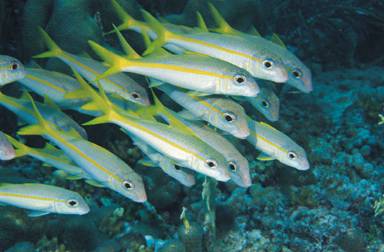
MARINE FISHES, PART I
Fossil records indicate that fish were the first vertebrate
animals.
They appeared more than 500 million years ago, probably evolving from a chordate relative like a lancelet (see unit 9). They are the most economically important marine animal. In addition to the obvious source of food, they are also used as fertilizer, chicken feed, glue, vitamins, leathers, and additives to many personal care items like make-up and deodorant. Fish will eat most things naturally occurring in the oceans and act as hosts to organisms ranging from bacteria all the way up to other fish.
Fish belong to the subphylum Vertebrata (vertebrate animals).
In addition to meeting the four characteristics of chordated animals, they also have a backbone (vertebral column) which functions to protect the nerve cord.
These are the most primitive of the vertebrate fishes. Since they do not have jaws, most representatives of this class feed by utilizing a suction cup surrounding a circular mouth full of teeth. They clamp onto their prey and hold on by the suction cup until a circular chunk of flesh is removed by the mouth. They have long cylindrical bodies that resemble snakes, and they lack the paired fins found in other fishes.

Hagfish - These organisms feed mostly on dead or dying fish. They will bore into their prey and eat them from the inside out. They are mostly found in cold water with muddy bottoms and can reach an adult length of about 3 feet. Only 20 species have been identified. Economically, they are collected for leather products, but are considered a pest organism because they attack fish trapped in fishermen's nets.
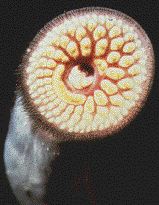
Lamprey - These are found all over the world in temperate regions. They are a freshwater fish during juvenile stages, but move into the oceans to breed as adults. They use their sucker to hold onto their prey and feed on their blood. Lamprey will also feed on bottom-living invertebrates. They are considered a pest because they attack fish in fishermen's nets, and are a particular problem in the Great Lakes of America where they have even been reported to have attacked human swimmers. There are about 30 identified species.
Class Chondrichthyes - Cartilaginous
fish
All the fish in this class have a skeleton made of cartilage, the same substance that makes up the human ear and nose. This would include sharks, rays, skates, and ratfish. These animals have movable jaws that typically are filled with lots of teeth, the presence of paired lateral fins to aid in swimming, and placoid scales that make the skin have a rough, sand-paper texture.
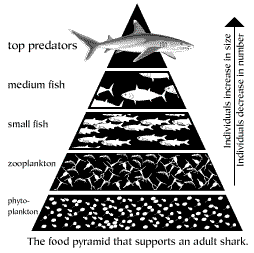
Sharks - While the word "shark" seems to always prompt fear in the swimmer, your actual chances of being attacked by a shark are quite small. Of the 350 identified species, only 5 are considered dangerous to man. Of course, any wild animal with teeth should always be treated with caution!
Sharks are called "living fossils" because their general body design has stayed almost the same for over 100 million years. The caudal (tail) fin is vertical, with the upper lobe usually being longer than the lower lobe (heterocercal design). Most species have two dorsal fins, with the first being larger and triangular in shape. Pectoral fins (corresponding to arms in humans) are paired and end in points. Five to seven external gill slits are present on each side of the body in an area that would correspond to the neck on humans.
Most sharks must swim continuously to force water across their gills. But, there are a surprising number of species that live on, or rest on, the sea floor. These animals will open and close their mouths to force water across the gills. Sharks have specialized organs for detecting the electrical impulses put out by all living organisms. They also have an exceptional sense of smell. It is believed that sharks can smell a single drop of blood in an area the size of a large swimming pool.
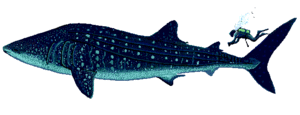
A size comparison of a whale shark and a human.
The largest fish in the ocean is the whale shark, which can reach 60 feet in length. However, this massive animal is a filter feeder, eating tiny plankton that pass into their open mouths while they swim. The great white shark is the largest of the predatory sharks, reaching 20 feet in length and found in all oceans of the world. Some of the smaller shark species are less than one foot long in the adult form.
Sharks do not have a swim bladder. But they do have extremely large livers that are full of oil. This oil helps the shark maintain its buoyancy, as well as being of economic value to man. Sharks are also used for food and their skins make very durable and expensive leather products. The current rate of harvest will cause many shark species to become extinct in the next 20 years. The U.S. and the governments of some other nations are working on laws that will set limits on how many sharks may be taken for food.
Male sharks have two claspers, one of which will be inserted into a female for direct transfer of sperm (sexual reproduction). Shark species exhibit all three forms of birth. Some are oviparous (egg layers), some are ovoviviparous (have eggs that hatch inside the female then the babies swim out), and some are viviparous (true live birth).
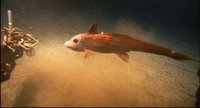
Ratfish - These are found in the deepest parts of the ocean. There are about 30 identified species of this fish, which is also known by the name chimaera. They feed on crustaceans and mollusks.
The dorsal lobe of the caudal fin is very long and thin. This is where the name ratfish comes from since this lobe resembles a tail on a rat. They also have a flap of skin that covers the external gill slits. This flap of skin is similar in function to the operculum in higher order fishes.